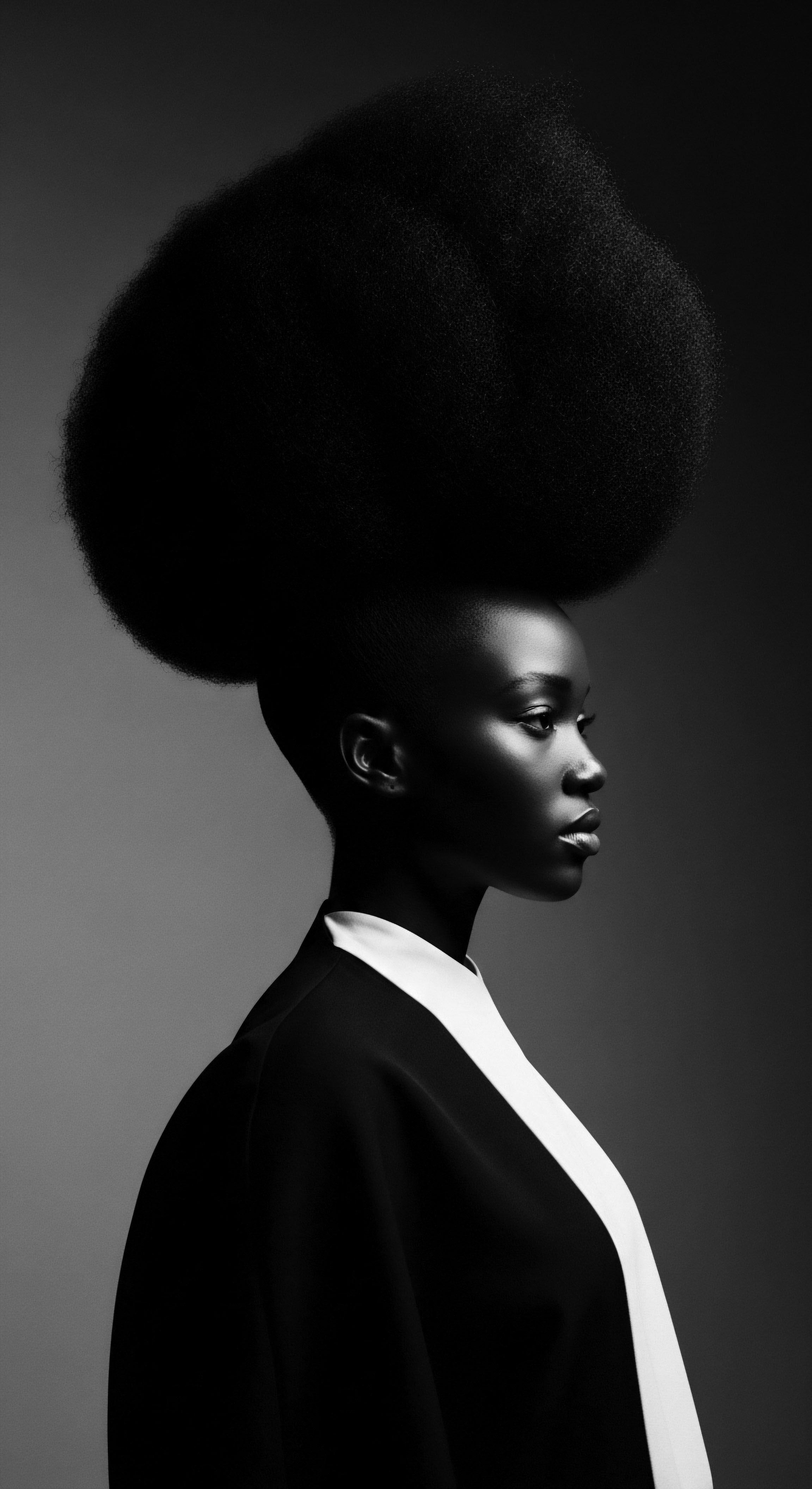
Roots
Standing at the genesis of hair’s story, we encounter not a mere physiological extension, but a deeply inscribed record of ancestral journeys. Our textured strands, in all their intricate coils, curls, and waves, carry whispers from epochs long past. They are a tangible link to the vibrant ingenuity and enduring wisdom of those who came before us, shaping practices of care long before laboratory compounds held sway. The question of whether traditional plant knowledge can inform future textured hair cleansing is not a simple query; it is an invitation to walk backward through time, to rediscover the elemental language of nature and its ancient dialogue with our hair’s unique biology and boundless spirit.

Hair’s Elemental Being from Ancient Perspective
The core of textured hair, from its follicular origin to the outermost cuticle, holds a distinctive architecture. Unlike straight hair, the elliptical cross-section and varying angles of growth in textured hair result in a cuticle layer that is more lifted and prone to exposure. This inherent structure, a gift of our heritage, often means a natural susceptibility to moisture loss and a greater need for gentle handling.
Our ancestors, without microscopes or chemical analyses, intuitively understood these attributes. They observed, felt, and responded to hair’s needs with remedies drawn directly from their surroundings.
For generations, the understanding of hair’s anatomy was not articulated in scientific journals, but in the skillful hands of caregivers. They recognized that a delicate balance was required to maintain scalp health and strand integrity. This knowledge was transmitted through communal practices, observation, and the passing down of recipes, each element carefully chosen for its perceived benefit to the hair’s very being. The concept of cleansing, then, transcended simple dirt removal; it connected to a broader sense of well-being and reverence for the crown.

Ancestral Classification of Hair
While modern trichology uses numerical and alphabetical systems to classify hair types, ancestral communities often categorized hair based on characteristics observed through a lifetime of interaction. They might speak of hair that drinks moisture, hair that thrives in a certain climate, or hair that takes to particular plant preparations. These classifications, though lacking formal scientific nomenclature, were deeply functional and culturally resonant, guiding individuals toward appropriate care specific to their lineage and environment. This classification system was experiential, rooted in thousands of years of living with and tending to textured hair.
Traditional plant knowledge offers a path to rediscovering elemental solutions for textured hair cleansing, respecting its unique structure and inherent needs.
This deep connection also shaped the very lexicon of hair care. Words for cleansing agents, conditioners, and styling tools often carried direct references to their plant origins or the cultural rituals they served. Consider the word “shampoo” itself, tracing its origins to the Hindi word Chāmpo, meaning to knead or press, derived from Sanskrit Chapayati, meaning to soothe.
This linguistic journey reflects a historical emphasis on scalp massage and nourishing herbal treatments in ancient India, long before commercial liquid soaps became commonplace (Natureofthings, 2024). This historical perspective grounds our present understanding in a profound, universal heritage of care.
The cycles of hair growth, too, were understood within the larger rhythms of life and the seasons. The idea that hair health was intrinsically linked to overall vitality, diet, and environment was self-evident. Historical records and oral traditions recount periods when certain plants or dietary shifts were associated with stronger hair. This holistic view, so often overlooked in contemporary discussions of hair care, serves as a powerful reminder of our ancestors’ integrated approach to health, where hair was an outward sign of an inner state.

Ritual
The essence of traditional cleansing extends beyond a functional wash; it manifests as ritual, a deliberate act of reverence for the hair and the self. These practices, passed down through generations, were often communal, fostering bonds and sharing wisdom. The wisdom of how to approach textured hair, with its unique needs for moisture retention and gentle handling, was embedded within these shared moments. It was here, in the tender attention given to each strand, that plant knowledge truly bloomed, becoming the very fabric of textured hair heritage.

Cleansing Rituals Across the Diaspora
Across the African continent and its diaspora, varied approaches to hair cleansing emerged, shaped by local botanicals and climate. In North Africa, for instance, women have long utilized Rhassoul clay (also known as Ghassoul clay) for thousands of years as a fundamental element in their beauty rituals, particularly for hair and body cleansing (Vertex AI Search, 2024; Vertex AI Search, 2019). This mineral-rich clay, sourced from the Atlas Mountains of Morocco, gains its name from the Arabic word ‘ghassala,’ meaning ‘to wash’ (Vertex AI Search, 2024; Vertex AI Search, 2019). It works by adsorbing impurities and excess oil without stripping the hair of its vital natural moisture, leaving it soft and conditioned (Vertex AI Search, 2019).
The preparation itself was often a secret family ritual, involving maceration of clay stones with local herbs like orange blossom, chamomile, and myrtus, further enhancing its properties (Vertex AI Search, 2024). This deep use highlights an ancestral understanding of gentle yet effective cleansing, aligning with the needs of textured hair. Another notable example hails from West Africa, where African Black Soap, formulated from plantain skins, cocoa pods, palm leaves, and shea tree bark, has long served as a versatile cleanser for both body and hair (Africa Imports, 2024). Rich in antioxidants and minerals, it offers a gentle cleanse that respects the hair’s inherent moisture (Africa Imports, 2024).

What Ancestral Ingredients Guided Hair Cleansing?
The plant kingdom served as a rich apothecary for cleansing agents. Our ancestors intuited the properties of various botanicals long before their chemical compounds were isolated and identified. Their wisdom came from observation, trial, and the generational transmission of knowledge. These ingredients, often simple yet profoundly effective, formed the bedrock of hair care in countless communities.
- Saponin-Rich Plants ❉ Many plants naturally contain saponins, compounds that create a foam when agitated in water, acting as natural surfactants (Kunatsa & Katerere, 2021). Examples include soapberries (Sapindus mukorossi) and shikakai (Acacia concinna), used historically in various parts of the world, including India, for hair cleansing (Natureofthings, 2024).
- Clays ❉ Beyond Rhassoul, various mineral clays, possessing high absorbent properties, were used to draw out impurities from the scalp and hair, contributing minerals and leaving a soft feel (Vertex AI Search, 2025).
- Herbal Infusions ❉ Leaves, barks, and roots from specific plants were steeped to create cleansing rinses, often chosen for their antimicrobial, soothing, or stimulating properties for the scalp (Kunatsa & Katerere, 2021).
- Fermented Waters ❉ Certain cultures, such as the Yao women of China, employed fermented rice water, not only for conditioning and strength but also as a mild cleanser for the scalp and hair (Vertex AI Search, 2025). This practice shows a deep knowledge of biochemical processes that enhance the properties of common ingredients.

Tools and Techniques of Ancient Cleansing
The rituals were not only about the ingredients but also the methods and tools used. Hand-kneading, gentle scrubbing with soft fibrous plants, and systematic rinsing were common. The goal was to remove buildup without undue friction, respecting the integrity of the fragile textured strands. Communal hair grooming was a social activity, strengthening familial and community bonds, especially among women (Vertex AI Search, 2024).
Hairdressers often worked only with members of their own gender, emphasizing the intimate and sacred nature of hair care (Vertex AI Search, 2019). This shared experience reinforced the oral transmission of care methods, ensuring that knowledge of specific plants and their application was preserved and adapted through time. The tools themselves were simple, yet perfectly suited to the task.
| Traditional Cleansing Agent Rhassoul Clay (Morocco) |
| Traditional Preparation / Use Mixed with water and herbs into a paste; applied as a hair and body wash. |
| Modern Scientific Link to Cleansing High cation exchange capacity, adsorbs impurities and excess sebum without stripping natural oils. Rich in silica, magnesium, potassium. (Vertex AI Search, 2024) |
| Traditional Cleansing Agent Saponin Plants (e.g. Shikakai, Soapberry) |
| Traditional Preparation / Use Pods or leaves boiled to create a foamy liquid for washing. |
| Modern Scientific Link to Cleansing Naturally occurring saponins act as mild surfactants, gently cleansing and conditioning hair. (Kunatsa & Katerere, 2021) |
| Traditional Cleansing Agent African Black Soap (West Africa) |
| Traditional Preparation / Use Derived from plantain skins, cocoa pods, palm leaves, shea bark; used as a multi-purpose cleanser. |
| Modern Scientific Link to Cleansing Rich in glycerin, antioxidants, and minerals, providing gentle cleansing and moisturizing effects. (Africa Imports, 2024) |
| Traditional Cleansing Agent These ancestral methods reveal an intuitive understanding of cleansing that respected hair's natural balance, a practice deeply embedded within textured hair heritage. |
The very act of cleansing was not isolated; it was part of a holistic philosophy that viewed hair as a spiritual extension of the self, a signifier of identity, status, and community (Vertex AI Search, 2024). Cleansing rituals often preceded important life events, symbolizing purification and new beginnings. This deep reverence for hair meant that cleansing was performed with intentionality, connecting the individual to their lineage and the earth from which their remedies came. This mindful approach to hair care offers profound lessons for contemporary practices.
Ancestral cleansing rituals, deeply woven into community life, showcased plant knowledge as a foundation for hair health and spiritual connection.

Relay
The echoes of ancient cleansing rituals, steeped in traditional plant knowledge, resonate with undeniable clarity today. The wisdom embedded in ancestral practices, often dismissed by colonial narratives, now finds validation in the tenets of modern science. This intersection offers a powerful lens through which to consider the future of textured hair cleansing, grounding innovation in heritage and sustainable wisdom. The relay of this knowledge from past to present is not merely an academic exercise; it represents a reclamation of identity and a re-centering of care practices around the intrinsic needs of textured hair, honoring a lineage of resilience.

Bridging Ancient Wisdom and Modern Understanding
The seemingly simple botanical washes of old carried complex biochemical properties. Plants like those rich in saponins, which froth when mixed with water, possess natural cleansing properties. Scientific studies confirm that saponins act as surfactants, reducing surface tension and helping to lift dirt and oils from the hair and scalp without the harsh stripping often associated with synthetic detergents (Kunatsa & Katerere, 2021; Kunatsa & Katerere, 2025). This gentle action is particularly important for textured hair, which benefits from cleansers that preserve its natural lipid barrier and moisture content, avoiding the dryness and breakage that can result from aggressive washing.
Consider the use of Rhassoul clay , a staple in North African beauty traditions for centuries (Vertex AI Search, 2024; Vertex AI Search, 2019). Modern understanding reveals this clay’s efficacy stems from its high mineral content—silica, magnesium, potassium—and its remarkable ability to adsorb impurities. Clay minerals possess a negative electrical charge, drawing out positively charged toxins, excess oils, and product buildup from the hair and scalp (Vertex AI Search, 2025). This purification process occurs without removing the hair’s natural moisture, making it an ideal, non-stripping cleanser for textured strands (Vertex AI Search, 2019).
The practice offers a powerful example of an ancestral method whose benefits are fully explained and supported by current chemical principles. Its continued use by Moroccan women today, even as part of traditional wedding offerings, underscores its enduring cultural and practical value (Vertex AI Search, 2024; Vertex AI Search, 2019).

What Does Science Reveal About Plant Cleansing?
The inherent architecture of textured hair, with its unique cuticle structure and predisposition to dryness, makes it particularly vulnerable to harsh cleansing agents. Modern research shows that natural, plant-derived ingredients can offer a gentler, more effective alternative. For instance, studies on vegetable oils, often used in traditional hair care for cleansing and conditioning, confirm their ability to penetrate hair fibers and improve resistance to mechanical stress, a significant benefit for delicate textured hair (MDPI, 2023). This scientific validation of centuries-old practices reinforces the idea that ancestral methods were not merely folk remedies, but often sophisticated, empirically developed solutions.
Research into botanical extracts in shampoo formulations suggests that plant-derived ingredients can significantly decrease surface tension, enhancing cleansing properties while contributing to improved hair texture and manageability (MDPI, 2020). These findings align with the ancestral understanding that plants provide comprehensive care, extending beyond mere hygiene to overall hair health and vitality.
The value of traditional knowledge is also evidenced in less commonly cited but powerful examples. The ethnobotanical studies of Afro-descendant communities in the Americas, for instance, reveal a continuation of plant-based healing and care traditions, despite the immense disruption of the transatlantic slave trade (Voeks, 2016). These communities, stripped of so much, clung to and adapted their botanical knowledge, often cultivating familiar African plants or integrating new ones found in their changed environments for medicinal and cosmetic uses (Voeks, 2016).
This perseverance speaks to the inherent efficacy and deeply rooted cultural significance of plant knowledge for hair care. The mere survival and adaptation of these practices demonstrate their efficacy, serving as a powerful historical example of enduring ancestral wisdom in the face of immense adversity.

Challenges and Opportunities
Integrating traditional plant knowledge into modern textured hair cleansing presents both challenges and exciting opportunities. Standardizing plant extracts, ensuring consistent quality, and scaling production while maintaining ethical sourcing are important considerations. The knowledge is often orally transmitted, requiring careful documentation and respectful collaboration with traditional custodians (Fajinmi et al. 2017).
However, the opportunities are substantial. Drawing from this heritage can lead to the development of highly effective, gentle, and sustainable cleansing products that truly honor the unique needs of textured hair. Such products move beyond superficial solutions, offering cleansing that supports the hair’s natural ecosystem, contributes to scalp health, and aligns with environmental consciousness. The shift represents a conscious move away from harsh chemicals and towards formulations that respect both the hair’s biology and its deep cultural lineage.
The future of textured hair cleansing, then, may well lie in a thoughtful backward glance. By respectfully re-examining the ancestral practices and the botanical wisdom they embody, we can discover not only innovative cleansing solutions but also reaffirm the profound connection between our hair, our heritage, and the healing power of the natural world.
Reclaiming ancestral botanical knowledge for textured hair cleansing validates historical practices with modern science, offering sustainable and culturally affirming pathways forward.

Reflection
To contemplate the future of textured hair cleansing through the lens of traditional plant knowledge is to stand at a profound confluence ❉ where ancient wisdom meets modern inquiry, where ancestral heritage informs contemporary care. It is a dialogue between the earth’s bounty and the intrinsic spirit of a strand. Our journey through the deep past of textured hair care, from the intuitive understanding of its anatomy to the elaborate rituals that bound communities, reveals a truth often obscured by the fleeting trends of the present ❉ the most profound solutions are frequently those that have stood the test of generations, refined by lived experience and passed down with care.
The Soul of a Strand, as we understand it, is not merely a biological entity; it is a repository of memory, a symbol of resilience, and a living archive of heritage. When we consider traditional plant knowledge for cleansing, we are not simply seeking alternative ingredients. We are engaging in a deeper act of recognition—acknowledging the ingenuity of our forebears, celebrating the biodiversity of our planet, and affirming the beauty of practices that were born of necessity and wisdom. These practices offer more than just clean hair; they provide a connection to a legacy of self-care that is inherently holistic, sustainable, and deeply rooted in cultural identity.
The enduring significance of this knowledge lies in its capacity to empower. To know that a cleansing ingredient comes from a plant, harvested and prepared with intention, connects us to a different relationship with our bodies and the natural world. It fosters a respect for natural cycles and a deeper understanding of what truly supports hair health. As we look ahead, the integration of traditional plant wisdom into textured hair cleansing promises a path that is not only scientifically sound and environmentally responsible but also profoundly meaningful, allowing each strand to carry forward the story of its heritage, unbound and luminous.

References
- Africa Imports. (2024). Traditional African Secrets For Long And Healthy Hair.
- Fajinmi, O. O. Olarewaju, O. O. & Van Staden, J. (2017). Traditional use of medicinal and aromatic plants in Africa. Medicinal and Aromatic Plants of the World-Africa Volume 3, 61-76.
- Kunatsa, Y. & Katerere, D. R. (2021). Checklist of African Soapy Saponin—Rich Plants for Possible Use in Communities’ Response to Global Pandemics. Journal of Pharmacy & Pharmaceutics, 8(4).
- Kunatsa, Y. & Katerere, D. R. (2025). Checklist of African Soapy Saponin—Rich Plants for Possible Use in Communities’ Response to Global Pandemics. ResearchGate.
- Leite MGA, Maia Campos P. (2018). Development and efficacy evaluation of hair care formulations containing vegetable oils and silicone. Int J Phytocos Nat Ingred. 5(1):9.
- MDPI. (2020). Influence of botanical extracts in the texture profile of shampoo formulations.
- MDPI. (2023). Penetration of Vegetable Oils into Textured Hair Fibers ❉ Integrating Molecular Matrix Assisted Laser Desorption Ionization Time-of-Flight Mass Spectroscopy (MALDI TOF/TOF MS) Analysis with Mechanical Measurements.
- Natureofthings. (2024). Getting To The Root of Hair Cleansing.
- Vertex AI Search. (2019). Everything You Need to Know About Rhassoul Clay ❉ For Hair and Skin Detoxification!
- Vertex AI Search. (2019). The History Of African Hair Culture. YouTube.
- Vertex AI Search. (2024). African Culture – Know Your Hairitage.
- Vertex AI Search. (2024). Ghassoul (Rhassoul) Clay ❉ Origin & History Of This Amazing Wonder!
- Vertex AI Search. (2024). Rhassoul ❉ a ritual for hair and skin care to purify and relax body and soul.
- Vertex AI Search. (2025). The ancient haircare secret that’s backed by modern science – Rolling Out.
- Voeks, R. (2016). Traditions in transition ❉ African diaspora ethnobotany in lowland South America. In African Ethnobotany in the Americas. Springer, New York, NY.
